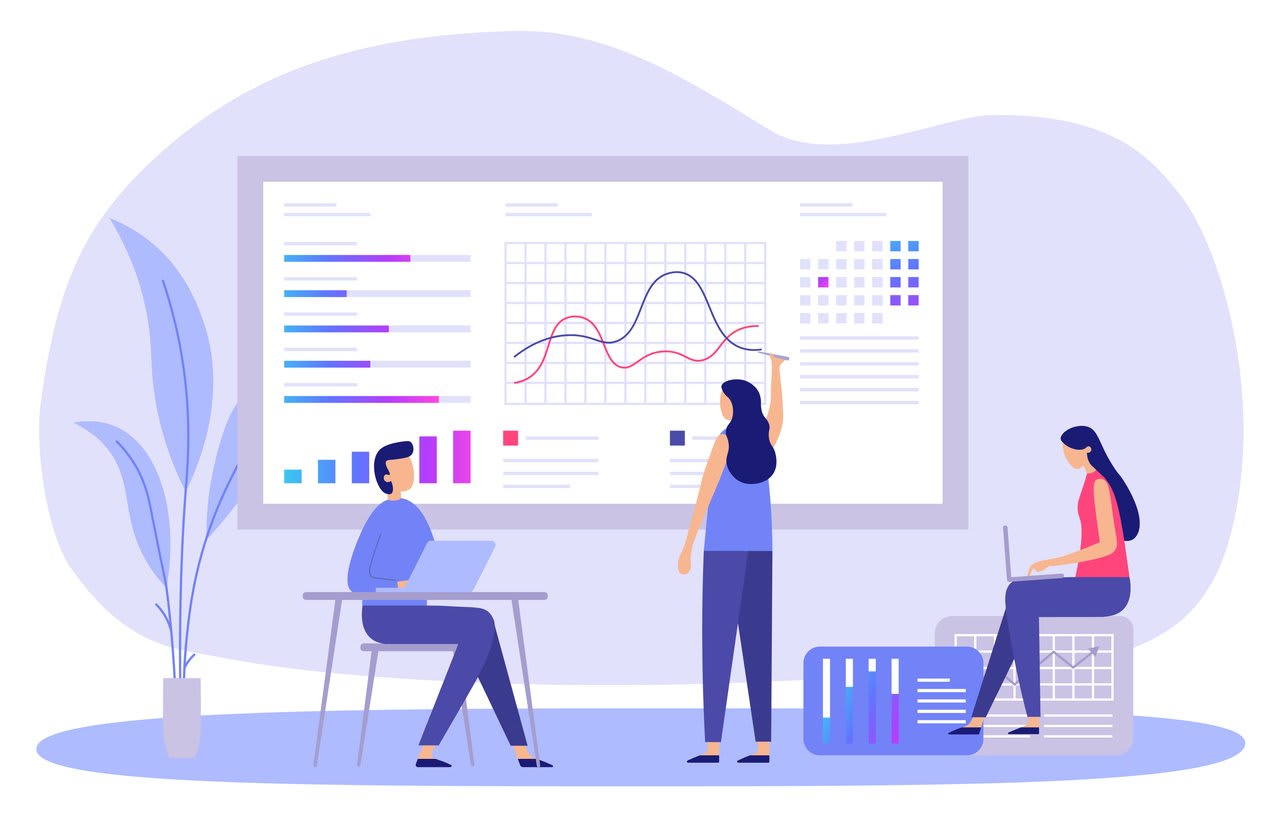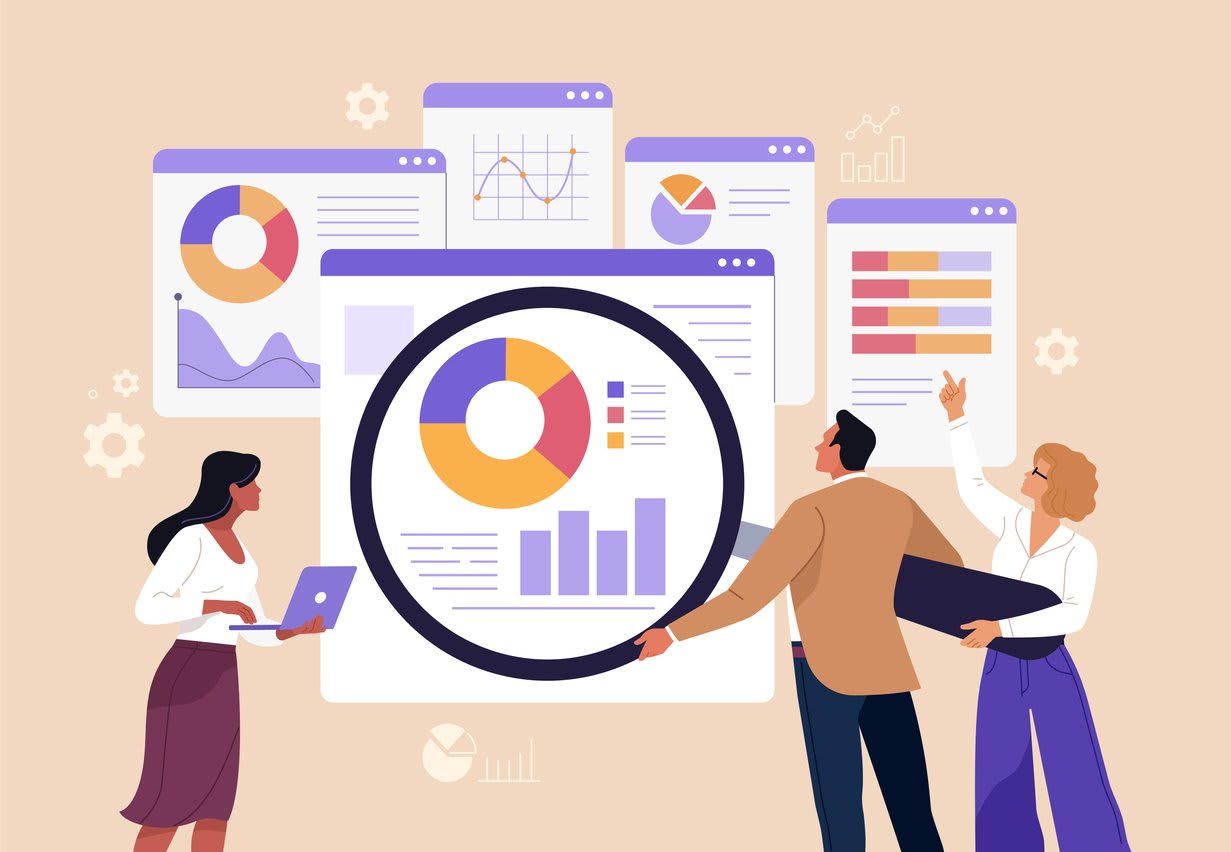People analytics is the practice of using employee data to enhance decision-making in organizations. It provides deep insights into performance, engagement, and satisfaction. This article will explain what people analytics is, why it’s important, and how it can benefit your company.
Key Takeaways
- People analytics provides valuable insights into employee performance, engagement, and retention, enabling organizations to drive meaningful change and optimize workforce management.
- Effective implementation of people analytics requires building a data-driven culture, selecting appropriate tools, and integrating HR systems to ensure comprehensive insights for informed decision-making.
- Future trends in people analytics are focused on leveraging generative AI, enhancing employee experience, and adopting agile HR practices to adapt to evolving workforce needs and optimize organizational success.
Understanding People Analytics

People analytics, also known as HR analytics or talent analytics, involves analyzing talent data about employees to solve business problems and enhance decision-making within an organization. Unlike traditional HR reporting, which often focuses on basic metrics and historical data, people analytics provides deeper workforce insights by interpreting people data from various sources, including HR systems, IT systems, and even external sources like salary surveys.
The primary goal of people analytics is to understand employees better and create a more effective work environment. Analyzing workforce data allows organizations to gain insights into employee performance, engagement, and satisfaction, driving organizational change. People analytics can uncover the reasons behind high employee turnover or identify the factors contributing to high-performing teams.
Organizations must collect and integrate various data points and interpret them to unlock insights and deliver insights that uncover meaningful insights for business data decisions. This process enables organizations to move beyond mere facts and figures, offering actionable insights and more insights that can lead to significant improvements in workforce management and business outcomes.
Key Benefits of People Analytics
People analytics offers numerous benefits that can significantly impact an organization’s success. Leveraging workforce data enhances employee performance, reduces turnover, and optimizes workforce planning through a people analytics strategy.
Organizations that effectively use people analytics are five times more likely to drive actionable change linked to business outcomes, leading to improved decision-making and overall business performance.
Enhancing Employee Performance
High-quality data is the cornerstone of effective people analytics. When HR leaders and teams have access to reliable data, they can make informed decisions that enhance employee experience and satisfaction. People analytics provides actionable insights to identify specific performance improvement areas for both individuals and teams. For instance, Google utilizes people analytics to assess employee performance and improve team dynamics, while Microsoft’s Manager Hub uses data analytics to inform managers about employee engagement levels, helping tailor approaches for team motivation.
A data-driven culture is vital for leveraging these insights effectively. Encouraging data literacy among employees helps them understand the significance of data-driven decisions and their influence on organizational culture and outcomes. This cultural shift towards data-driven decision-making supports continuous improvement and enhances overall employee performance.
Reducing Employee Turnover
One of the most significant advantages of people analytics is its ability to reduce employee turnover by:
- Analyzing workforce data to reveal patterns in employee behavior
- Enabling proactive turnover risk management
- Uncovering specific turnover triggers
- Allowing HR teams to implement targeted retention strategies and improve overall employee satisfaction.
Moreover, people analytics software can help organizations better understand the reasons behind employee departures, leading to enhanced employee engagement and retention. It achieves this by:
- Tracking metrics such as time-to-fill and offer-acceptance rates
- Significantly improving the overall employee experience
- Leading to higher retention rates and a more stable workforce.
Optimizing Workforce Planning
The evolution of people analytics allows organizations to optimize talent management and workforce planning through advanced data analysis. Predictive analytics helps companies anticipate workforce challenges and align their hiring practices with future organizational goals.
This proactive approach ensures that businesses have the right critical talent in place to achieve their strategic objectives, ultimately driving strategic decision-making and organizational success through talent development.
Types of People Analytics
People analytics encompasses various types of data analysis techniques, each serving a unique purpose in understanding and improving workforce dynamics:
- Descriptive analytics focuses on analyzing historical data to understand past workforce events, providing a solid foundation for further analysis.
- This type of analytics helps organizations identify trends and patterns in employee behavior.
- It enables organizations to make informed decisions.
Diagnostic analytics takes this a step further by seeking to uncover the reasons behind trends and anomalies identified in the data. Understanding the underlying causes of workforce issues allows organizations to develop targeted interventions and strategies to address specific challenges. For example, diagnostic analysis can help HR teams understand the factors contributing to low employee engagement or high turnover rates.
Predictive analytics utilizes historical data to forecast future trends and employee behaviors, allowing organizations to anticipate and prepare for potential workforce challenges. Prescriptive analytics goes even further by recommending specific actions based on these predictions to optimize HR outcomes. Combining these advanced analytics techniques allows organizations to unlock valuable insights and drive meaningful changes in workforce management practices.
Implementing People Analytics

Implementing people analytics requires several critical steps: building a data-driven culture, selecting the right tools, and integrating HR systems. These steps are essential for organizations to leverage people analytics effectively and achieve improved business performance through data-driven decision-making.
Building a Data-Driven Culture
A critical aspect of people analytics is its role in fostering evidence-based decision-making within HR practices. Key points include:
- Building a data-driven culture starts with small, targeted experiments that address specific organizational challenges.
- These experiments demonstrate the return on investment (ROI) of people analytics initiatives.
- Communicating the benefits of analytics effectively is crucial to securing support from leadership and other stakeholders.
- For example, Google leverages people analytics to enhance decision-making and boost team effectiveness through data-driven insights into employee performance.
Agile methodologies in HR allow organizations to quickly adapt to changing HR processes through iterative processes and real-time feedback. Implementing agile HR practices encourages flexibility and responsiveness to workforce data, allowing organizations to adapt quickly to changing employee needs and fostering a more responsive workforce strategy.
Selecting the Right People Analytics Tools
Selecting the right people analytics tools is crucial for effective implementation. Organizations should consider software solutions that offer functionalities to break down and visualize data clearly, such as Visier, Inc. for businesses with hourly workers and SAP Analytics Cloud for predictive analytics. The integration of generative AI can further enhance HR efficiency by automating data analysis and producing actionable insights.
User-friendliness is another critical factor to consider when selecting people analytics software. Tools like Kumospace, recognized for providing actionable workforce insights, and Deel, ideal for global workforce management, ensure that HR teams can effectively utilize the software to monitor various HR metrics and understand their impact on business outcomes.
Integrating HR Systems
Integrating existing HR systems is crucial for obtaining comprehensive data insights that can enhance decision-making. Effective data integration from various HR sources ensures that the analytical insights generated are relevant and actionable, allowing businesses to align hiring practices with future organizational goals and enhance operational efficiency.
Case Studies of Successful People Analytics Implementation
Real-world examples of successful people analytics projects implementation, such as those from Google, Microsoft, and Kumospace, demonstrate the significant impact of people analytics on organizational success. These companies have leveraged people analytics to enhance team performance, drive employee engagement, and optimize remote work environments.
Google utilizes people analytics teams to enhance team performance and support informed decision-making, fostering a data-driven culture. Leveraging data insights, Google has improved team dynamics and overall productivity, showcasing the power of people analytics in driving business outcomes.
Microsoft
Microsoft’s Manager Hub is designed to enhance employee engagement and improve management practices. Integrating people analytics enables the Manager Hub to provide data-driven insights that inform managers, fostering employee engagement and overall productivity using Microsoft Excel.
Kumospace
Kumospace employs people analytics to optimize remote work environments, enhancing collaboration and productivity among distributed teams. Understanding user behavior and focusing on employee experience, Kumospace has significantly boosted engagement metrics and overall satisfaction in remote work settings.
Overcoming Challenges in People Analytics
Implementing people analytics often encounters hurdles like data integration complexities, organizational resistance, and securing stakeholder buy-in. Overcoming these challenges is crucial for effective implementation and driving value from HR data.
Ensuring Data Privacy and Compliance
Adhering to data privacy regulations maintains user trust and prevents legal repercussions in people analytics. Maintaining transparency and robust security measures when handling employee data fosters trust and ensures compliance with privacy regulations.
Addressing Data Quality Issues
To ensure high-quality quantitative data, organizations must integrate various data systems and standardize definitions and metrics across platforms. A robust data collection framework is crucial for gathering accurate and relevant data for analysis, helping maintain consistent data quality.
Gaining Stakeholder Buy-In
Gaining stakeholder buy-in is essential for the successful implementation of people analytics. Demonstrating the return on investment (ROI) of analytics initiatives and aligning them with business goals helps secure support from leadership and other stakeholders.
Future Trends in People Analytics

Emerging technology trends are driving advancements in people analytics, making it essential for organizations to adapt. Trends like using generative AI, focusing on employee experience, and adopting agile HR practices are shaping the future of people analytics.
Leveraging Generative AI
Generative AI represents a transformative approach in HR, allowing investment in advanced technologies to improve efficiency. Automating routine HR tasks and analyzing vast sets of employee data with generative AI enables HR professionals to become strategic partners within their organizations, enhancing overall workforce management.
Focusing on Employee Experience
There is a growing emphasis on using people analytics to enhance employee satisfaction and experience. Kumospace uses people analytics to tailor remote work environments, enhancing collaboration and productivity among distributed teams, including the core team.
This focus on employee experience leads to higher employee engagement and overall workforce satisfaction.
Adopting Agile HR Practices
Agility in HR refers to the ability to quickly adapt processes and strategies in response to shifting workforce needs and market conditions. Implementing agile methodologies helps HR teams respond promptly to changing data insights and HR initiatives, fostering an environment of continuous improvement.
Setting up feedback loops and iterative cycles in their processes enhances data-driven decision-making and ensures alignment with real-time insights. This approach not only aligns HR functions with business objectives but also enhances employee engagement, continuous feedback, and responsiveness.
Summary
In conclusion, people analytics is a powerful tool that can transform the way organizations manage their workforce. By understanding the different types of people analytics and implementing them effectively, companies can enhance employee performance, reduce turnover, and optimize workforce planning. Real-world examples from companies like Google, Microsoft, and Kumospace demonstrate the significant impact of people analytics on organizational success. As we look to the future, trends such as generative AI, a focus on employee experience, and agile HR practices will continue to shape people analytics. By overcoming common challenges and fostering a data-driven culture, organizations can unlock the full potential of their workforce and achieve lasting success.
Frequently asked questions
People analytics is the process of using data about employees to address business challenges and improve decision-making within an organization. By leveraging this analysis, companies can optimize talent management and drive better organizational outcomes.
People analytics significantly enhances employee performance by delivering actionable insights that pinpoint specific areas for improvement, thus enabling better decision-making and fostering a more supportive work environment. This data-driven approach ultimately leads to a more engaged and high-performing workforce.
People analytics consists of four main types: descriptive analytics, diagnostic analytics, predictive analytics, and prescriptive analytics, each serving a distinct role in enhancing workforce understanding and performance. Emphasizing these analytics can significantly inform strategic decision-making in human resources.
Organizations can ensure data privacy and compliance in people analytics by adhering to relevant regulations, maintaining transparency with stakeholders, and implementing robust security measures. These practices help build user trust and mitigate legal risks.
The future of people analytics will increasingly revolve around generative AI, enhancing employee experience, and implementing agile HR practices. Organizations must embrace these trends to stay competitive and effectively manage their workforce.





